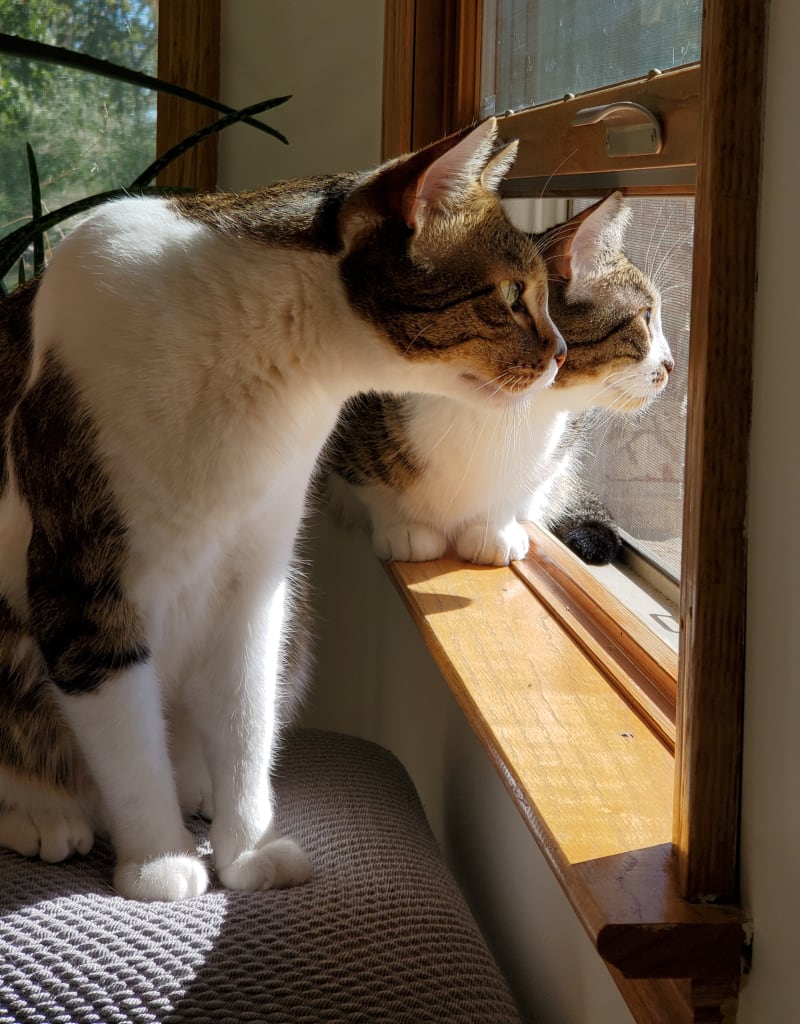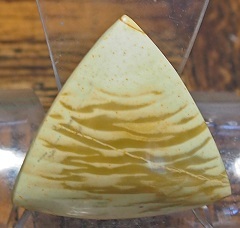|
|
Post by jasoninsd on Oct 11, 2021 20:45:37 GMT -5
I guess I misunderstood your original question...which basically made my comments more of a "Captain Obvious" type of statements more than anything else. And again, maybe I'm too new to this to try and give any worthwhile insight...but that isn't going to stop me from trying! LOL Your originally stated issue... "I have no problem putting a decent dome on a tear drop or oval, but when I make cabs with narrow points or with lots of flat sides, I get confused about how to shape the dome. I often end up grinding the dome too low (girdle too thin) as I approach the points, and leaving it too high along flat sides." I guess for me, I go for the geometric center of the cab, regardless of shape. I don't grind the girdle too thin or too high. The very first grind I make on any cab (regardless of shape) is a 45(ish) grind that follows the girdle line all the way around the perimeter of the cab. I also draw the girdle line around every cab I work. I don't work from the dome down toward the girdle line (until the entire shaping is done - then I will to "smooth" out the grinding lines). Once that initial grind is done, the girdle line is set. The next grind is at an angle that removes half of the material from that initial grind to the geometric center (the "top" of the dome). The third grind "rounds" out that last bit of material that's left. When it comes to shapes with a narrow point, the first and second grind is "elongated" in that section...it's more of a 20-30 degree in the narrow point section versus the 45 degree - depending on how pointed that section gets. To avoid the "ridge" that would be created following two straight edges on that initial grind, the movement of the cab is curved or rounded as I go around that corner. I think Tela tried to describe this move...if I was reading what she was writing correctly. It sounds like your approach is similar to Tela's. Maybe you can post some profile shots of your recently completed Montana agate when you get a chance. I was not trying to be a smart ass in my response to you, although I see how it might have come across that way. I did not understand your comment to be merely pointing out the obvious. There is just this tension between having an even, smooth, rounded (what I call lens shaped) dome, and any geometric shaped cab. What I am exploring, with the help of you all, is how to resolve that tension. You, Steven, and Tela, have all provided some good options and insights. Thank you! I will definitely get some pics posted for you...although that one HAS been one of my worst subjects to photograph! LOL I will also say I think I'm understanding the "tension" you're describing...and this is maybe why I'm not experienced enough to fully understand the solution either...but in my mind I don't think one CAN get anything similar to a "lens" shaped dome on anything that's a "geometric" shape - anything that isn't circular(ish) in nature... So, I'm with you...if someone can address that - and has a viable solution, I'm all ears too!  |
|
|
|
Post by parfive on Oct 11, 2021 20:47:32 GMT -5
Round 'em all up and ya got a council ready to counsel.
|
|
|
|
Post by holajonathan on Oct 12, 2021 1:51:37 GMT -5
parfive Ok, Mr. Webster, you caught my errant homophone (almost) usage. I got distracted while trying to work up an alliterative phrase with the initials CCCP, just for you, to see if you'd catch it. I got stuck on the P, however... "cabochon creation console p______." If I had found a P work, I would have mentioned my 5-year plan for creating a record number of cabochons for the glory of mother Russia. Not quite as oblique as some of your comments, but hey, I can try. At various times in the past decade, I have officially held the titles of counselor and councilor. Cats don't console. But they are something akin living art work.  
|
|
|
|
Post by jasoninsd on Oct 13, 2021 0:10:59 GMT -5
It sounds like your approach is similar to Tela's. Maybe you can post some profile shots of your recently completed Montana agate when you get a chance. I was not trying to be a smart ass in my response to you, although I see how it might have come across that way. I did not understand your comment to be merely pointing out the obvious. There is just this tension between having an even, smooth, rounded (what I call lens shaped) dome, and any geometric shaped cab. What I am exploring, with the help of you all, is how to resolve that tension. You, Steven, and Tela, have all provided some good options and insights. Thank you! I will definitely get some pics posted for you...although that one HAS been one of my worst subjects to photograph! LOL I will also say I think I'm understanding the "tension" you're describing...and this is maybe why I'm not experienced enough to fully understand the solution either...but in my mind I don't think one CAN get anything similar to a "lens" shaped dome on anything that's a "geometric" shape - anything that isn't circular(ish) in nature... So, I'm with you...if someone can address that - and has a viable solution, I'm all ears too!  So I have to post a public apology to holajonathan and say I was TOTALLY wrong about me not dipping my corners! I seriously never saw it on this cab until I took close-ups of the corners! (And now I see scratches on the one corner!) Holy smokes I've got a lot of learning to do still...and I'm off to eat some crow!    |
|
|
|
Post by jasoninsd on Oct 17, 2021 23:37:43 GMT -5
I've been thinking about something for a few days related to dipped corners. The other night I couldn't fall asleep, so what did I occupy my brain with? That's right...I kept trying to figure out why I had dipped my corners on that Montana Agate! holajonathan - This might be another "Captain Obvious" thing...but I had no clue about the cause of the dipped corners until I started thinking about it. My conclusions are based on the use of a flat lap, so I don't know if they will relate to a cabbing machine or not...but I think maybe they do...depending on how the cab is oriented to the surface of the wheel. I was pretty dang sure when I had shaped the Montana on the 80 grit, and the 180 grit disks that I had NOT dipped the corners. It dawned on me the other night that I probably hadn't...and that's because they're hard disks. I realized that when I apply pressure, I can remove a fair amount of material (even on agates) with the 500 and even the 1200 disks. All of my disks past the 180 (meaning 220 and above) are resin disks with a sponge backing. This enables the disk to follow the continuity of the cab easier. Now the ability to compress works ideal for any "rounded" or "curved" surface. However, it becomes murder on anything with a straight edge with corners. The reason why, is when the straight edge is pressed into the surface of the disk, the sponge backing and the disk do not compress in a straight line. The compression is CURVED! The curvature is minimal along the middle area of the straight edge on the cab, but once the compression gets to the corners, the upward curve is tremendous! So, any pressure applied to a straight edge will subsequently create a "dip" in the corners. This picture illustrates what is happening on the surface of the disk. The ruler is the straight edge on the cab and the sponge is the disk. Look at the corners of the ruler. The sponge is curving excessively at the corners to accommodate the pressure applied to the ruler. So, on a cab, this would cause excessive material loss on those corners...creating a "dipped" corner. Now I've figured out the cause...I need to figure out a solution...  |
|
|
|
Post by stephan on Oct 18, 2021 0:18:25 GMT -5
Tela has enough experience to where I’m going to guess that the ridges were left for a reason. I’ve done so myself on occasion, just for the variety. |
|
|
|
Post by knave on Oct 18, 2021 0:23:41 GMT -5
Jason. Thoughtful and helpful post.
It’s true the finer grits can remove material like crazy with enough pressure.
The other factor is, constant pressure against the wheel does not equal constant (psi) on the wheel.
A high heeled shoe 👠 (worn by average person) has more psi on the heel than a large tractor or vehicle does on its tires.
When you get to a pointy tip on a cab. The arm force is concentrated on that tiny point much like the heel of that shoe.
Just rambling lol
|
|
|
|
Post by stephan on Oct 18, 2021 0:30:31 GMT -5
parfive Ok, Mr. Webster, you caught my errant homophone (almost) usage. I got distracted while trying to work up an alliterative phrase with the initials CCCP, just for you, to see if you'd catch it. I got stuck on the P, however... "cabochon creation console p______." If I had found a P work, I would have mentioned my 5-year plan for creating a record number of cabochons for the glory of mother Russia. Not quite as oblique as some of your comments, but hey, I can try. At various times in the past decade, I have official held the titles of counselor and councilor. Cats don't console. But they are something akin living art work.   “Plane” starts with p. It’s a stretch, but something. I beg to differ on cats consoling. Maybe not all, but Sophie, our seasoned citizen cat is very in tune. She can tell when I’ve had a day, and will come over and groom me. |
|
|
|
Post by parfive on Oct 18, 2021 1:16:54 GMT -5
|
|
|
|
Post by stephan on Oct 18, 2021 8:39:46 GMT -5
True, but plane makes more sense as a flat work surface |
|
|
|
Post by holajonathan on Oct 18, 2021 9:28:12 GMT -5
My cabs are more mortal sins than peccadillos. Mea Culpa, Mea Culpa, Mea Maxima Culpa. |
|
|
|
Post by holajonathan on Oct 18, 2021 10:55:49 GMT -5
I've been thinking about something for a few days related to dipped corners. The other night I couldn't fall asleep, so what did I occupy my brain with? That's right...I kept trying to figure out why I had dipped my corners on that Montana Agate! holajonathan - This might be another "Captain Obvious" thing...but I had no clue about the cause of the dipped corners until I started thinking about it. My conclusions are based on the use of a flat lap, so I don't know if they will relate to a cabbing machine or not...but I think maybe they do...depending on how the cab is oriented to the surface of the wheel. I was pretty dang sure when I had shaped the Montana on the 80 grit, and the 180 grit disks that I had NOT dipped the corners. It dawned on me the other night that I probably hadn't...and that's because they're hard disks. I realized that when I apply pressure, I can remove a fair amount of material (even on agates) with the 500 and even the 1200 disks. All of my disks past the 180 (meaning 220 and above) are resin disks with a sponge backing. This enables the disk to follow the continuity of the cab easier. Now the ability to compress works ideal for any "rounded" or "curved" surface. However, it becomes murder on anything with a straight edge with corners. The reason why, is when the straight edge is pressed into the surface of the disk, the sponge backing and the disk do not compress in a straight line. The compression is CURVED! The curvature is minimal along the middle area of the straight edge on the cab, but once the compression gets to the corners, the upward curve is tremendous! So, any pressure applied to a straight edge will subsequently create a "dip" in the corners. This picture illustrates what is happening on the surface of the disk. The ruler is the straight edge on the cab and the sponge is the disk. Look at the corners of the ruler. The sponge is curving excessively at the corners to accommodate the pressure applied to the ruler. So, on a cab, this would cause excessive material loss on those corners...creating a "dipped" corner. Now I've figured out the cause...I need to figure out a solution...  Your observation is absolutely correct, or at least consistent with how I have been thinking about corners. On the softer wheels, I almost try to avoid the corners, or just graze the wheels past them with minimal pressure. Even so, because the pressure is greater at a point or edge, the corners end up getting the same amount of sanding as the other parts. Similarly, I try to leave corners a little higher when I am grinding the bevels to create the dome. It is the same reason I try to stay a fraction of a mm above the girdle line. It is easy enough to take the corners down a little with the 280 or 600 grit resin wheels if needed, but once they are ground low there is no bringing them back up. Using the beveling method (illustrated in my photos) helps somewhat in keeping pressure off the corners when sanding, because beveling each side individually will initially create pronounced ridges that run from the geometric middle of the cab to the corners. How much you flatten out those ridges as you even out the dome and move to the resin wheels (or discs) is a matter of personal preference, but the ridges help prevent me from accidentally sliding off a corner, putting all of my pressure on a tiny point. I'm not sure I can explain exactly why that is the case, but in general, having a higher, flatter ridge pointing to a corner tends to protect the corners better than having the dome slope towards the corners. Our minds must work alike, because I try to understand exactly why and how something is happening before I feel like I can keep it from happening. If I could only understand exactly how rocks get polished in a vibratory tumbler. I've been thinking about that one for almost two years now. |
|
|
|
Post by stephan on Oct 18, 2021 18:58:19 GMT -5
My cabs are more mortal sins than peccadillos. Mea Culpa, Mea Culpa, Mea Maxima Culpa. If that's the case for one broken cab and a few dipped corners, I am screwed. Maybe if I fix my mistakes before I die? |
|
|
|
Post by knave on Oct 18, 2021 19:25:10 GMT -5
My cabs are more mortal sins than peccadillos. Mea Culpa, Mea Culpa, Mea Maxima Culpa. If that's the case for one broken cab and a few dipped corners, I am screwed. Maybe if I fix my mistakes before I die? Hand them all to the priest. (Me) |
|
|
|
Post by parfive on Oct 18, 2021 21:04:36 GMT -5
I wasn’t referring to the cabs but feel free to park that console o’ yours on a podium, maestro, and step up for the glory.  |
|























